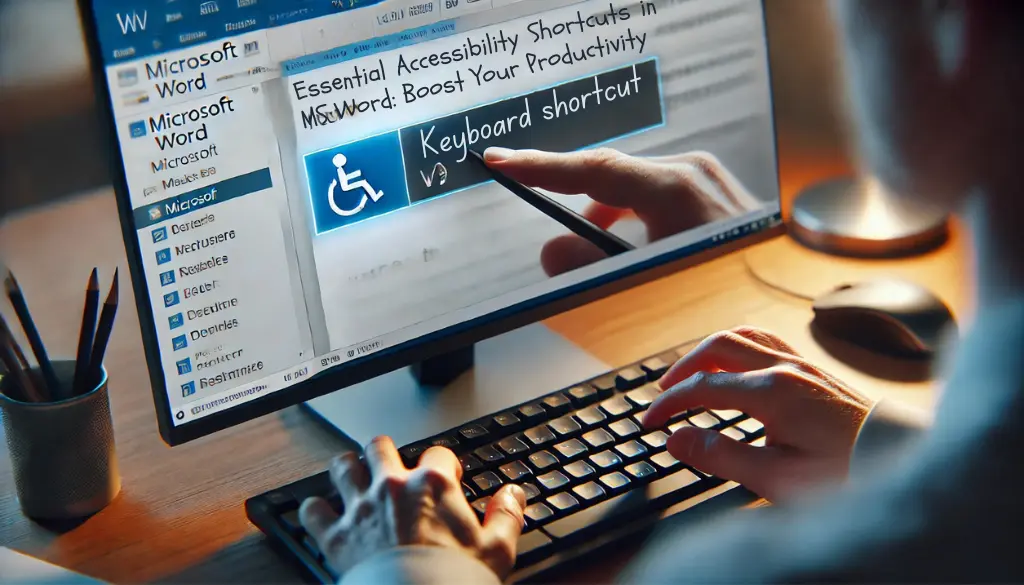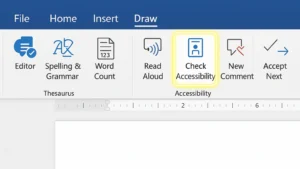Last Updated: August 8, 2025
Microsoft Word’s accessibility features, including Accessibility Shortcuts in MS Word, ensure everyone can create and edit documents easily. Accessibility is crucial for users who have disabilities or prefer keyboard navigation to interact with documents. Learning Accessibility Shortcuts in MS Word, such as using Alt + R to run the accessibility checker, can save you time and make your workflow more inclusive.
For additional tips, check out editing invoice templates in Microsoft Word. In this article, we will cover the essential Accessibility Shortcuts in MS Word to maximize accessibility and improve your overall productivity.
Table Of Contents
Top Shortcuts for Accessibility Features in MS Word
If you struggle with navigating the MS Word ribbon due to a disability or simply prefer using the keyboard, there’s a shortcut for you.
- Shortcut: Press Alt to highlight the ribbon. From there, use the arrow keys or letters that appear to navigate through the options.
- Pro Tip: Once you press Alt, letters will show up on each tab and command, allowing you to quickly access specific features without using a mouse.
2. Use the Accessibility Checker
For more information on how to make your documents accessible, check out Microsoft’s guide on making Word documents accessible.
- Shortcut: Press Alt + R, then A to open the accessibility checker.
- Why It Matters: This shortcut helps ensure that your document meets accessibility standards, making it easy for everyone to read and understand.
3. Add Alt Text to Images
Adding alternative text (alt text) to images is essential for users who use screen readers. This helps describe the content of images for visually impaired individuals.
- Shortcut: Select an image and press Alt + J + D + A to open the alt text pane.
- Accessibility Tip: Make your alt text descriptions clear and concise, so users know what the image conveys.
4. Zoom In and Out Effortlessly
For users with visual impairments, changing the zoom level can make a big difference in document readability, such as when editing detailed charts or reading small text.
- Shortcut: Press Alt + W, then Q to open the zoom dialog box.
- Quick Access: You can also use Ctrl + Mouse Scroll to zoom in and out if you prefer.
The navigation pane helps users with disabilities quickly move through different parts of a document without scrolling manually.
- Shortcut: Press Ctrl + F to open the navigation pane, then use Tab and arrow keys to move between headings.
- Efficiency Tip: This shortcut is particularly useful for lengthy documents where finding specific sections might be difficult.
Frequently Asked Questions About Accessibility Shortcuts in MS Word
How Do Accessibility Shortcuts Improve Productivity?
Accessibility Shortcuts in MS Word make it easier for users to navigate and create content without needing a mouse. You might also want to learn how to create a booklet template in Microsoft Word to make your documents more engaging. These shortcuts reduce the time spent searching for options and increase focus on writing and editing.
Are These Shortcuts Available in All Versions of MS Word?
Most accessibility shortcuts are available in recent versions of MS Word, including Microsoft 365 and MS Word 2016 onward. However, some features like the accessibility checker may not be available in older versions, which could limit document accessibility. Ensure your software is up to date to take advantage of the latest accessibility improvements.
How Can I Customize Accessibility Shortcuts?
You can customize shortcuts by going to File > Options > Customize Ribbon. Assign your preferred key combinations to commonly used features for a more personalized experience.
Conclusion
Accessibility shortcuts in MS Word are essential for making the program more user-friendly and inclusive. From navigating the ribbon to adding alt text and using the accessibility checker, these shortcuts will not only save time but also help ensure your documents are accessible to all. You can also explore using label templates in Microsoft Word to further enhance accessibility. Start using these shortcuts today to make your work in MS Word more efficient and inclusive.
Don’t forget to share these accessibility tips with others—together, we can make document creation more inclusive for everyone!





